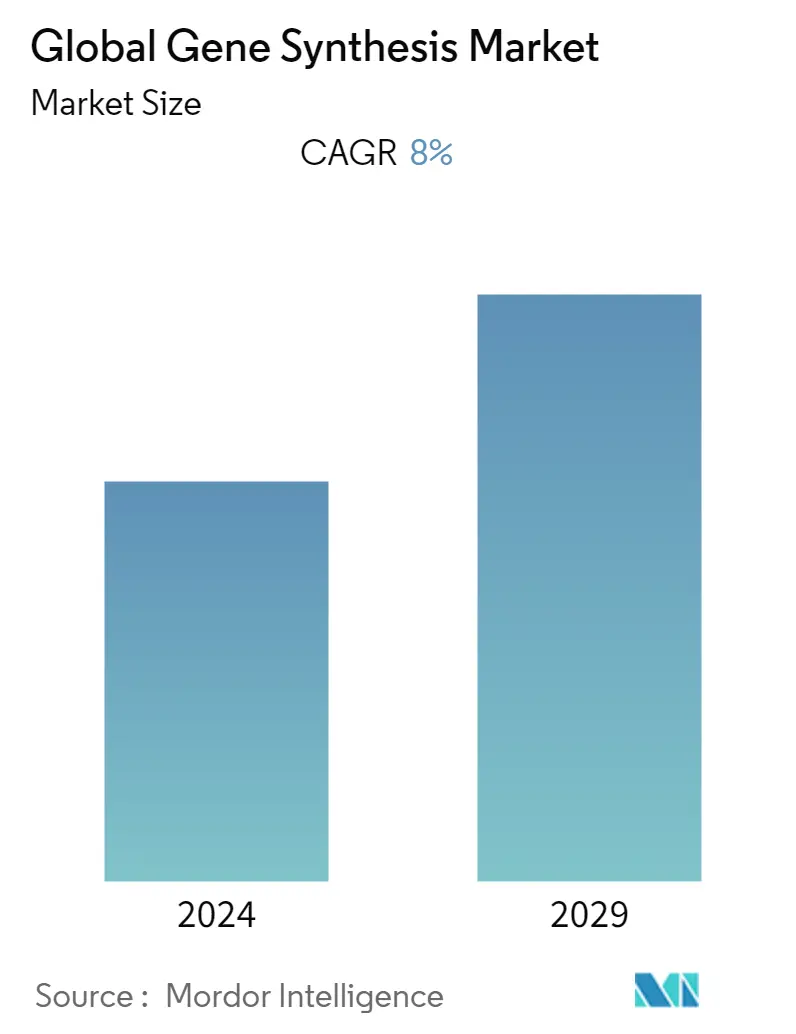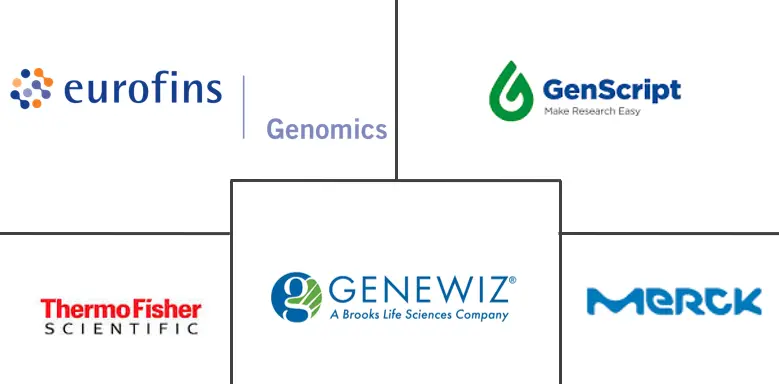
| Study Period | 2019 - 2029 |
| Base Year For Estimation | 2023 |
| Forecast Data Period | 2024 - 2029 |
| Historical Data Period | 2019 - 2022 |
| CAGR | 8.00 % |
| Fastest Growing Market | Asia Pacific |
| Largest Market | North America |
Major Players
*Disclaimer: Major Players sorted in no particular order |
Gene Synthesis Market Analysis
The Gene Synthesis market is expected to register a CAGR of nearly 8% during the forecast period (2022-2027).
The COVID-19 pandemic has impacted the gene synthesis market in both ways, negatively and positively. At the start of the COVID-19 pandemic, most of the businesses and research activities around the world ceased due to the increasing rate of infection from the SARS-CoV-2 virus which not only reduced the use of gene synthesizers in laboratories but also the demand for it in the market. But in the quest for developing vaccines against the virus infection, which was rising in every corner of the world, the gene synthesizers played a very crucial role in the research and development of the vaccine as some of the vaccines are mRNA based and due to its efficiency too. For example, in January 2022, the Food and Drug Administration provided second approval to the mRNA-based COVID-19 vaccine from Moderna called Spikevax. Therefore, gene synthesis played a crucial role during the COVID-19 pandemic, and the market is expected to grow further.
The factors that are responsible for the growth of the Gene Synthesis market include increasing research and development in the field of genomics and next-generation sequencing, increased government funding for genomics, and increasing demand for personalized medicine and therapeutics for different chronic diseases. As personalized medicine aims to provide tailor-made therapies to individual patients, depending on the molecular basis of the disease, it has become popular over recent years. Healthcare technology, genomics, connected devices, big data analytics, and artificial intelligence are generating vast amounts of health-related data and insights which is enabling healthcare providers to offer better and faster diagnostics and treatment services by making more informed treatment decisions. In addition, gene synthesis is also finding its applications in the molecular diagnosis of infectious and genetic diseases. Genetic tests, which can detect genetic variations and predict how a person is likely to respond to certain drugs, are becoming commercially available. Therefore, increasing focus on personalized medicine and other factors, such as a patient-centered approach, are driving the growth of the gene synthesis market.
Factors, such as the aging global population and the rising prevalence of chronic diseases, are putting unrelenting pressure on the capacity and financial viability of the healthcare systems across the world and will also play a role in the driving growth of the gene synthesis market. Personalized medicine holds the promise of providing better patient care and a high safety margin while lowering total healthcare costs. As per the data published in December 2021 by International Diabetes Federation (IDF), there were about 537 million adults (20-79 years) who were living with diabetes in 2021 all over the globe and the federation projected that this number would rise to 783 million by 2045. The lack of skilled professional is the major restraining factor for the growth of the gene synthesis market as the devices are overly complex and needs special attention while handling and it's very difficult to find an expert professional for handling. Another factor that will also have a role in the inhibition of the market growth is the excessive cost and complexity of the devices.
Gene Synthesis Industry Segmentation
As per the scope of the report, gene synthesis refers to the in vitro, base-by-base synthesis of double-stranded DNA molecules. Unlike DNA replication, which occurs in-vivo or by polymerase chain reaction (PCR), gene synthesis does not require a template strand for its initiation. The Gene Synthesis Market is Segmented by Method (Oligonucleotide Synthesis and Gene Assembly), End User (Academic and Research Institute, Biopharmaceutical Companies, And Contract Research Organizations), And Geography (North America, Europe, Asia-Pacific, Middle East and Africa, And South America). The Report Offers the Value (in USD Million) For the Above Segments.
| Oligonucleotide Synthesis | Solid Phase Phosphoramidite Synthesis |
| Microchip-based Oligonucleotide Synthesis | |
| Gene Assembly | Ligation-mediated Assembly |
| PCR-mediated Assembly |
| Academic and Research Institutes |
| Biopharmaceutical Companies |
| Contract Research Organizations |
| North America | United States |
| Canada | |
| Mexico | |
| Europe | Germany |
| United Kingdom | |
| France | |
| Italy | |
| Spain | |
| Rest of Europe | |
| Asia-Pacific | China |
| Japan | |
| India | |
| Australia | |
| South Korea | |
| Rest of Asia-Pacific | |
| Middle East and Africa | GCC |
| South Africa | |
| Rest of Middle East and Africa | |
| South America | Brazil |
| Argentina | |
| Rest of South America |
Global Gene Synthesis Market Size Summary
The gene synthesis market is poised for significant growth, driven by advancements in genomics and next-generation sequencing, alongside increased government funding and a rising demand for personalized medicine. The market experienced both challenges and opportunities during the COVID-19 pandemic, as the initial halt in research activities was countered by the critical role of gene synthesis in developing mRNA-based vaccines. This dual impact has underscored the importance of gene synthesis in healthcare innovation. The market's expansion is further supported by the growing application of gene synthesis in molecular diagnostics for infectious and genetic diseases, as well as the integration of healthcare technology, big data analytics, and artificial intelligence, which enhance diagnostic and treatment capabilities.
North America, particularly the United States, dominates the gene synthesis market due to its robust healthcare infrastructure, significant government investment in research, and the presence of key industry players. The market is moderately competitive, with major companies like Merck KGaA, Genewiz Inc., and Eurofins Genomics leading the way. Despite the challenges posed by the complexity and cost of gene synthesis technologies, the market is expected to grow, driven by the increasing prevalence of chronic diseases and the need for efficient healthcare solutions. Innovations in polymerase chain reaction techniques and the introduction of advanced nucleic acid synthesis technologies are anticipated to further propel market growth.
Global Gene Synthesis Market Size - Table of Contents
1. MARKET DYNAMICS
- 1.1 Market Overview
-
1.2 Market Drivers
- 1.2.1 Increasing R&D in the Field of Genomics and Next Generation Sequencing
- 1.2.2 Increased Government Funding Toward Genomics
- 1.2.3 Increasing Demand for Personalized Medicine
-
1.3 Market Restraints
- 1.3.1 Lack of Skilled Professionals
- 1.3.2 High Cost and Complexity of Techniques
-
1.4 Porter's Five Forces Analysis
- 1.4.1 Threat of New Entrants
- 1.4.2 Bargaining Power of Buyers/Consumers
- 1.4.3 Bargaining Power of Suppliers
- 1.4.4 Threat of Substitute Products
- 1.4.5 Intensity of Competitive Rivalry
2. MARKET SEGMENTATION (Market Size by Value - USD million)
-
2.1 By Method
- 2.1.1 Oligonucleotide Synthesis
- 2.1.1.1 Solid Phase Phosphoramidite Synthesis
- 2.1.1.2 Microchip-based Oligonucleotide Synthesis
- 2.1.2 Gene Assembly
- 2.1.2.1 Ligation-mediated Assembly
- 2.1.2.2 PCR-mediated Assembly
-
2.2 By End User
- 2.2.1 Academic and Research Institutes
- 2.2.2 Biopharmaceutical Companies
- 2.2.3 Contract Research Organizations
-
2.3 Geography
- 2.3.1 North America
- 2.3.1.1 United States
- 2.3.1.2 Canada
- 2.3.1.3 Mexico
- 2.3.2 Europe
- 2.3.2.1 Germany
- 2.3.2.2 United Kingdom
- 2.3.2.3 France
- 2.3.2.4 Italy
- 2.3.2.5 Spain
- 2.3.2.6 Rest of Europe
- 2.3.3 Asia-Pacific
- 2.3.3.1 China
- 2.3.3.2 Japan
- 2.3.3.3 India
- 2.3.3.4 Australia
- 2.3.3.5 South Korea
- 2.3.3.6 Rest of Asia-Pacific
- 2.3.4 Middle East and Africa
- 2.3.4.1 GCC
- 2.3.4.2 South Africa
- 2.3.4.3 Rest of Middle East and Africa
- 2.3.5 South America
- 2.3.5.1 Brazil
- 2.3.5.2 Argentina
- 2.3.5.3 Rest of South America
Gene Synthesis Market Research FAQs
What is the current Global Gene Synthesis Market size?
The Global Gene Synthesis Market is projected to register a CAGR of 8% during the forecast period (2025-2030)
Who are the key players in Global Gene Synthesis Market?
Merck KGaA, Genewiz Inc., Eurofins Genomics, Thermo Fisher Scientific and GenScript are the major companies operating in the Global Gene Synthesis Market.


